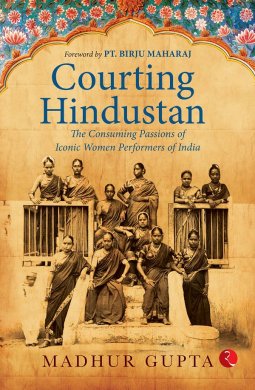
|   |

|   |
Courting Hindustan - Radhika Rani e-mail: asmozonic@gmail.com June 12, 2023 Courting Hindustan: The Consuming Passions of Iconic Women Performers of India Author: Madhur Gupta Rupa Publications, New Delhi (2023) Price: INR 295 ISBN: 978-93-5702-103-6  When we think about the Sepoy Mutiny (as the British labelled it) or the First War of Independence (as Nehru insisted on calling it), we instinctively associate it with images of macho men leading a spirited rebellion against the Raj, as it was to become. What we don't associate it with, is a valiant attempt by Begum Hazrat Mahal to combat the annexation of Awadh by organising a successful military resistance and crowning her son (Birjis Qadr) as a rightful successor to the throne. Her tactful reign lasted for almost ten months and she "outsmarted" (Gupta, 2023, p. 93) the British regiments while en route to seeking asylum in Nepal, where she stayed put until her death. This Begum was not a regular royal wife, though. She was trained in the classical dance form of Kathak and transformed into a feisty courtesan through sheer dint of her character. Madhur Gupta's Courting Hindustan is brimming with many similarly fascinating anecdotes about the rich and inspiring lives of women performers across Indian history. Through a series of ten chapters, Gupta carefully re-constructs the nuanced lives of some of the most famous female performing artistes from medieval to modern India. And in doing so, he offers an alternative interpretation that challenges the otherwise prevalent perception of such performers as being the bane of our society and its 'culture'. Since women's bodies have always been considered as the repository of a family or community's honour, individuals who chose to defy the patriarchal norms of morality were deemed as unworthy of respect and prominence. That courtesans managed to assert their autonomy despite this kind of disregard is truly commendable. By writing Courting Hindustan, Gupta makes a valiant attempt at challenging the impact of the colonial project that infused a distinct Victorian morality in Indian society. Some of the ways it materialised itself was by criminalising homosexuality and socially maligning the stature of tawaifs. In discussing the astuteness of the begum performers, Gupta presents an authentic image of gravitas that could not be slighted by the fact that they were female artistes. The book comes into its own in the second half when the author engages with multiple sources to present a compelling narrative of the baijis or gaanewalis, as the courtesans from Awadh were popularly known. Artistes like Janki Bai and Jaddan Bai were pioneers of the classical performing arts with their deep knowledge and practice of the same. These knowledge traditions were carefully nurtured and passed on to female performers, mostly in a matrilineal line of inheritance. Recently, scholars have begun to revisit their glorious history and contributions in detail. We have seen that through Manjari Chaturvedi's The Courtesan Project (2019) and Vikram Sampath's book My Name is Gauhar Jaan: The Life and Times of a Musician (2012). The latter was even adapted into a play by Mahesh Dattani. Lilette Dubey directed Rajeshwari Sachdev to evocatively portray the challenges and triumphs of Gauhar Jaan on stage. In the musical O Gaanewali! (2022), Avanti Patel showcases the art and history of these accomplished women performers in a warm and interactive manner. Such works of art present an alternative viewpoint and make us realise the challenges faced by the tawaifs who struggled to maintain their social standing in a rapidly changing political atmosphere that concertedly maligned them and their art. Gupta's book is carefully researched and an important addition to this body of work that goads us to re-examine our biases about the social and cultural significance of these female artistes. It is a feminist reclaiming of narrative and grows on the reader with each passing page. The book closes with a particularly enlightening discussion on Balasaraswati whom the author has called the last standing courtesan of India. As an iconic Bharatanatyam dancer who resisted the 'purification' of this ritual dance form, Balasaraswati was "instrumental in taking the regional performing art across the globe" (Gupta, 2023, p.170). Gupta devotes considerable space to discussing this doyenne's life course which was marked by the achievement of immense political and cultural prominence. It could have been made more engaging by the inclusion of at least a few photographs to accompany the vivid narrative. Courting Hindustan contributes to a growing body of scholarly exposition on the historical, social and cultural relevance of women in the history of Indian performing arts. In conclusion, this book can be seen as a catalyst to scrutinise the presently prevalent majoritarian agenda that's peddling deeply patriarchal notions about women's autonomy, role and position in society. It is recommended for readers of all age groups and serves as an excellent introductory text to women's history in this context. The book will hopefully also empower its readers to question any piece of information masquerading as a historical fact and examine the various nuances of its narrative.  Radhika Rani teaches sociology and anthropology at a college under the aegis of Mumbai University. Her research interests lie at the intersection of gender rights, popular resistance and identity assertion. She is also pursuing her doctoral research at the Tata Institute of Social Sciences, Mumbai. Post your comment Please provide your name / email id when you use the Anonymous / blog profile to post a comment. All appropriate comments posted in the blog will also be featured in the site. |